[updated 2024]
Although I bought Jamie Jackson’s, Paddock Paradise book over 3 years ago, I have not been able to implement anything yet as I am still boarding my horses on other people’s land – where I have already sunk tons of money just to create a dry paddock area for them to eat in our super rainy, muddy climate here in BC, Canada!
But it looks like we will be ready to move to our own property within the next year (fingers crossed!) so I have stepped up my research, and begun fleshing out my plan for my ideal Paddock Paradise/walking track/equine permaculture habitat, and came across this simply fabulous example from Marja van Run in Holland.
I mean, just LOOK at how much FUN her Icelandic horses are having with their waterhole in their 2.5 acre Paddock Paradise!
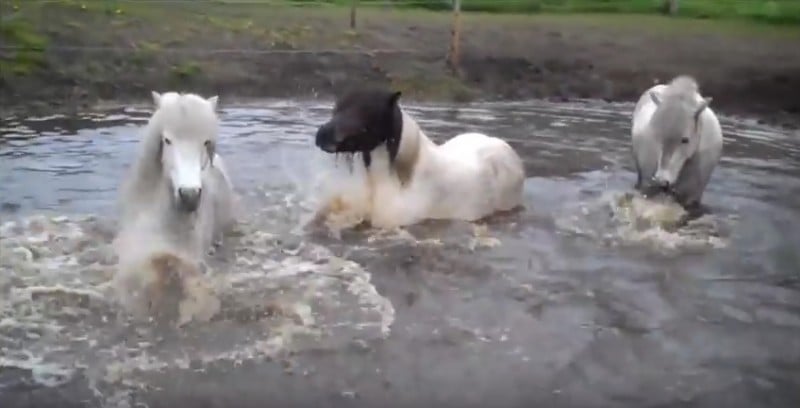
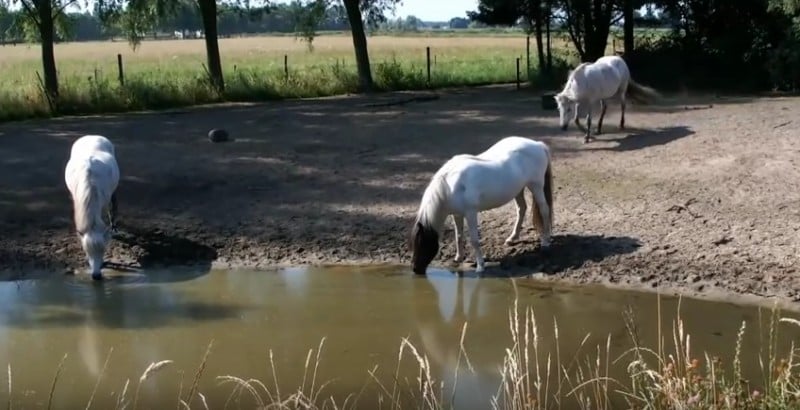
I’m going to be sharing more about Marja’s (and other’s) excellent Paddock Paradise setups in future posts, but for now, let’s just focus on this waterhole. I watched about four different videos on Marja’s YouTube Channel and sifted through dozens of video comments to distill down the important info for us. So let’s turn this over to Marja for some how-to…
How do you keep the waterhole clean and fresh?
Marja van Run writes, “If a pond is big enough it is self sustaining, so I don’t do anything to the water to keep it clean. It is a living organism though, and I could clearly see my pool go through different phases from the moment it was dug. But it can take a few years before it reaches that balance.”
“Over the years we have seen the water gradually becoming cleaner. At first it had a lot of algae on the surface and one summer we had weird pink flakes in the water which turned out to be some kind of bacterial pollution”:
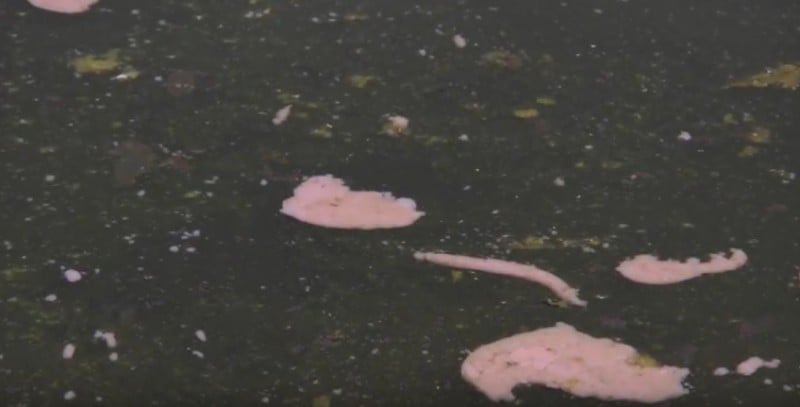
“So we closed off the pond to the horses, but it disappeared in 3 days and didn’t come back. Last year there was no algae and instead we saw a lot of duckweed (which the horses loved!)”:
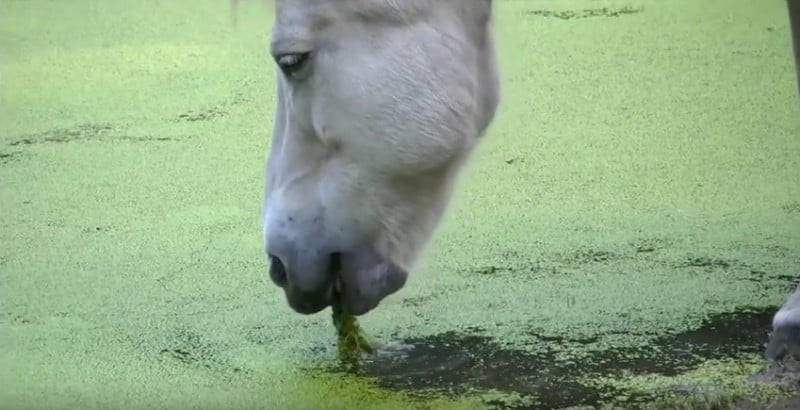
“So I guess the waterhole is going through all kinds of phases and slowly coming into a more balanced state now. By the way, the horses always have a free choice between drinking from the waterhole or tapwater from a tub. They usually prefer the waterhole.”
Do you line the bottom of the pond with anything?
Marja says, “There is no foil or anything else on the bottom of the waterhole. This is the natural groundwater level, so nothing is needed to keep the water in there.”
“First we drilled a small hole at the driest time of year (August/September) to see how deep the groundwater level was. Then I drew a plan with the depth of the waterhole (2 metres deep) about 80 cm lower than the groundwater level (so that the waterhole would never dry up), a steep bank on one side and a very gradual one on the other side. Then we made a hill with the dirt from the waterhole.”
Here’s the video showing how Marja dug her waterhole and then used the excavated earth to build a nice hill for the horses to romp on at the other end of her Paddock Paradise. I don’t know about you, but I will be showing this to my excavator guy when I’m ready to create a waterhole for my horses!:
Those of you who have read Jamie Jackson’s book, or studied Paddock Paradise models, know it is very important to vary the terrain as much as possible. And horses LOVE playing on hills, gravel piles, compost piles, or anything else piled up or asking to be climbed. And what could be better for their agility? So I just love, love, love this idea of doubling up the benefits by getting a waterhole and a great climbing hill all in one go!
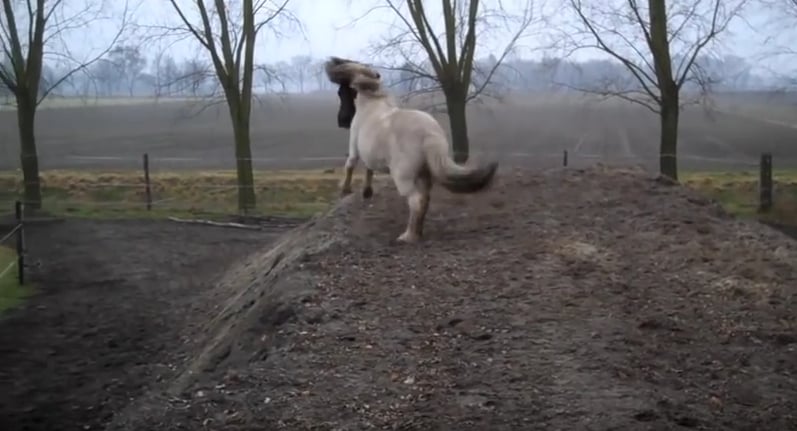
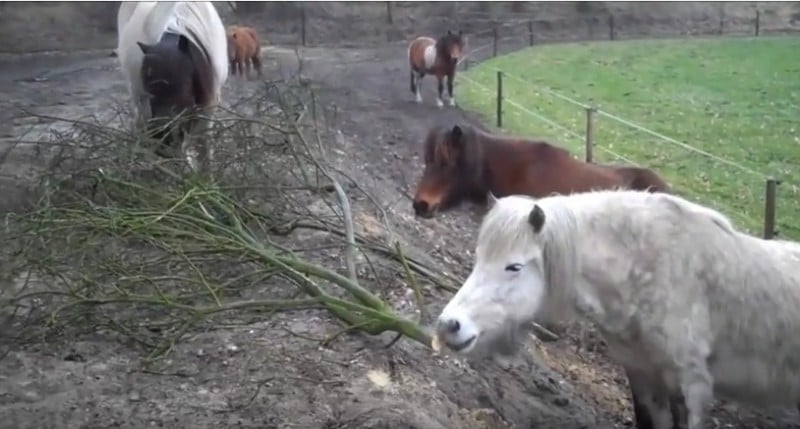
Marja has a few videos showing how much the waterhole enriches her ponies’ lives, something I did not fully realize before. I thought it was a great idea, but I didn’t realize how it’s actually crucial to their natural enjoyment and behaviour.
My Fjord/Belgian gelding, Montaro, has been begging me to open up access to the creek again, at the back of their pasture. Unfortunately, the fencing in the back portion of the field is often taken out by trees falling on it. So when they crossed into the neighbour’s property after a windstorm last month, and she threatened to phone the SPCA (while I was in Mexico!), I closed off the back portion. But after watching these horses cavort, explore, enjoy and utilize their waterhole, I understand WHY it is so important for him to have access.
I was going to save this most fabulous video for the next post, but the waterhole footage is just too good to leave out. If you want to go straight to the waterhole video footage, start watching at 22 minutes:
Finally! My two waterholes at the Singing Horse Ranch
When I first wrote this post, I could only dream of having my own land and being able to have a waterhole for the horses. Fast-forward 5 years and I was finally able to manifest the land of my dreams on 160 acres, and put in a gorgeous waterhole for the horses and wildlife.
The ranch came with a nifty waterhole already in place, but you can see how I cleaned that up and dug a second waterhole – and why.
Wait! I can’t afford a big waterhole right now – any alternatives?
Well, funny you should ask, because Cynthia Cooper has a fantastic, super easy, DIY tutorial about how to make a hoof bath from materials you probably already have lying around. You can use this to hydrate your horses hooves during dry weather:
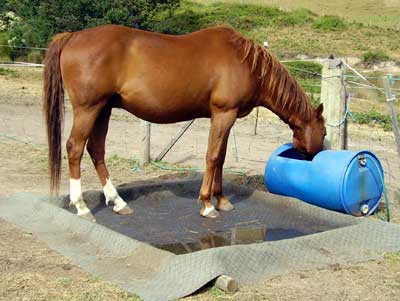
And even incorporate it into your walking track (Paddock Paradise), like Tina Brandt from Horse Harmony NZ did:
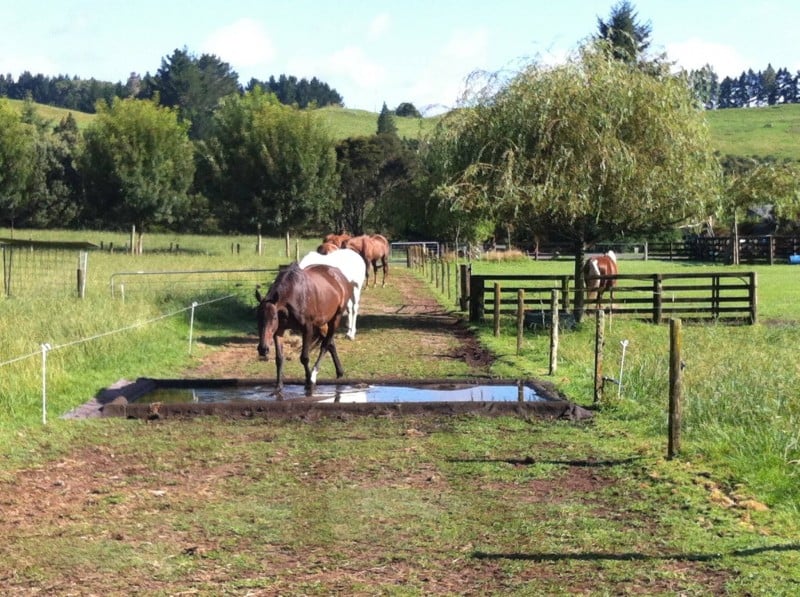
As Tina says: “Last year the horses hooves got really dry with the dry summer we had, so this year with the impending El Nino, I wanted to rectify this rather than using hoof creams etc. I installed a hoof bath earlier in the year across a part of their track system, which has solved this problem, although it hasn’t nearly been as dry as anticipated. But I am really happy with the results of this simple way of hydrating their hooves.”
Needless to say, if you have a horse that’s squeamish about walking in water, this would also be a good way to teach the horse that water is okay and even no big deal. Once you’ve supported the horse through their first encounter or two, when things are part of a horse’s natural environment, even the scariest items become normal after a few weeks.
One final example
Just to make sure you’re as fully ensconced in waterhole-envy as I am, I’m going to leave you with this aerial photo of how Horse Haven has incorporated a waterhole into their walking track, and then a video showing it in closer detail and how their horses use it:
Aeration stones for mosquito control
Lastly, if you’re wondering how Horse Haven keeps their waterhole from becoming a mosquito breeding ground, owner Suzannah was kind enough to give me the details.
They use something called air stones, or, aeration stones. Suzannah got theirs from a pond supply shop. She used 3 inch stones, placed 4 feet apart on either side of their waterhole.
She also said they haven’t gotten clogged with algae or needed to be cleaned, since they put them in 2 years ago. Here’s some more information on air stones and examples of what they look can like.
Equine ethologist, Lucy Rees’ videos on Epona TV, also show how a waterhole is crucial for natural fly relief during the summer months. So that’s something else to add to the list of benefits bestowed by providing a waterhole for our horses!

Jini Patel Thompson is a natural health writer and Lazer Tapping instructor. She began riding at age 2 in Kenya, and got her first horse at age 8 in Alberta, and so continues a life-long journey and love affair with these amazing creatures.

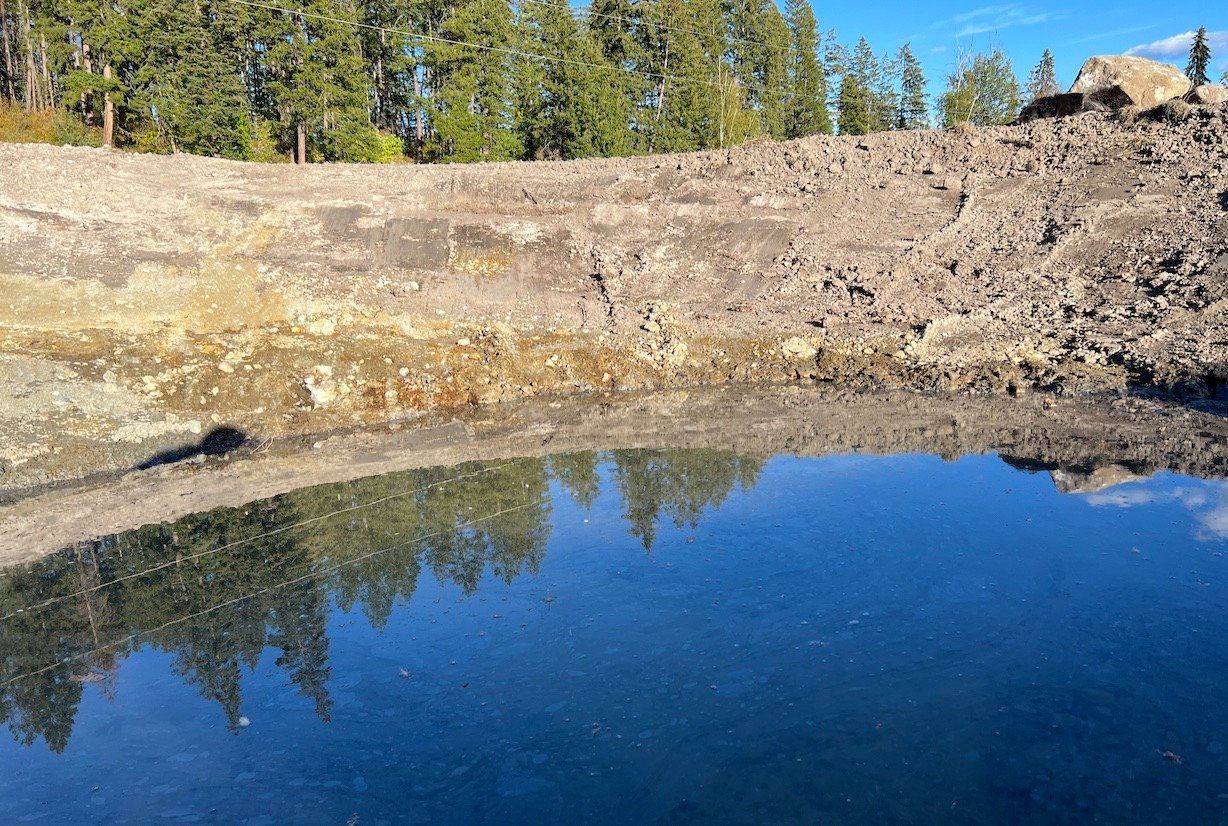
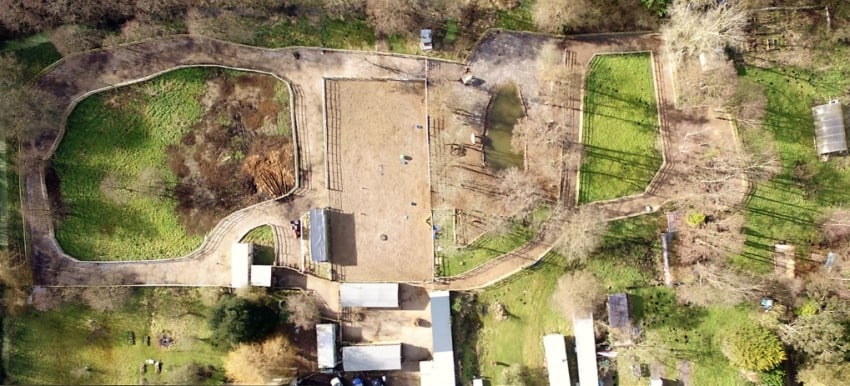







Thank you Jini for ‘spreading the news’ :-)! This is why I make these videos, to hopefully show others what can be done to enrich the lives of their horses.
You’ve done a wonderful job Marja and your video is hands down the best one out there on Paddock Paradise setups – both the how, the why, and how to do it on a small property. Thank you for sharing your gifts with us!
My pleasure :-)!
Wow, the BEST PADDOCK PARADISE I have ever seen. Thanks for sharing Jini and thank you Marja for creating this.
Jini – I love your research abilities and your blogging. I never found Marja PP videos during my searching. About the water hole, in your fantastic research, if you come across the exact opposite of a wet climate which is where I live – how to build a water hole and keep the water in. I live on a granite base, dry scrub land, cactus, bunch grass and sage brush. The water runs off or through the ground like a sieve and you can’t keep water anywhere. So I would need to line this water hole. If you come across ideas in this area could you please share? I am thinking that the horses will destroy any lining you put in.
Susan
Thanks Susan! Marja might have some ideas, but what I have heard people do in your situation is to line the pond/waterhole with industrial-strength liner (not gardening liner) and then add a few layers of RIVER rock on top of the liner. River rock (tumbled rock) is smooth and rounded so will not tear fabric when pressure is applied. The first layer is a larger size river rock, then a second layer is added with smaller sized river rock that fills in all the holes/gaps and also makes it more comfortable for the horses to stand/lie on.
I also found this interesting guide – not what you’re asking, but may provide some good ideas to GET water into your pond:
http://www.acmesand.com/wp-content/uploads/2015/09/Rain-Garden-resource-guide.pdf
Also, why don’t you contact the sponsors of this publication, as I’m sure they will know what to do, either the Arizona State Forestry Division, or Watershed Management Group – which is non-profit:
https://watershedmg.org/services/home
I will also tag Sarah Lockwood from http://www.earthandequine.com – who I’ll be doing a teleseminar with shortly, and see if she has any ideas for you.
Hi Susan,
Jini has brought forward a couple of sound ideas regarding placement of a pond liner and the size distribution of the bottom rock. As an alternative to an industrial liner, you could import clay and create a compacted clay liner for the pond. More on this below.
You will want to look at placement of your pond so as to receive as much clean runoff as possible, and hopefully be in a lower or natural recharge area. If you have any faults on your land, sometimes there are springs and sag ponds associated with them that could create a source of water (don’t build the pond right on the fault).
I think in a low groundwater table condition such as yours, you would need to look at rainwater harvesting to have water to send to your pond. However, if you fight your climate too much, you will at some tipping point go from application of Permaculture techniques (conservation of energy) to addition of energy to your system. This is OK, but you should understand where that tipping point is, and the cost and work associated with it before you try to keep a wet pond, year-round, in a geologic and climatic condition that does not naturally support it. For instance, if you go with a clay lined pond and allow it to dry out seasonally, the clay can shrink and crack, which could cause it to be susceptible to damage during the dry season and not hold as well during the wet season. Or, if you decide to keep it wet year-round, does your rainy season and rainwater harvesting system provide enough water to keep it filled? Be sure to design the size of your pond with the volume of available stored water in mind, and consider the cost and ecological implications of adding water (your well water or city water) to the system.
Once you decide how to line and fill your pond, you need to consider how to keep the water longer by providing shade and perhaps a bit of an ecosystem. Shade would also increase the longevity of an industrial liner by reducing UV exposure. Water holes are kindof a “rabbit hole” if you know what I mean! I would encourage you to look at the resources available to wild horses in similar conditions to yours, and aim to provide those first – I know Mr. Jackson also incorporates a sand pit for rolling in his Paddock Paradise model. And your granite base probably is a great abrasive for the hooves.
I apologize that this reply jumps around a lot – just wanted to bring forward the main considerations needed in the site planning of a pond in your conditions. Hope that helps! – Sarah Lockwood http://www.earthandequine.com
Sarah,
Thank you for such a professional reply. You bring up valid points. I do not get enough moisture/rain/snow to keep the pond going. I would have to feed it from my well. This is probably such a waist of a valuable resource in my area besides being costly.
Back to the drawing board!
Susan
I’m sorry it wasn’t better news… but always better to consider broad questions ahead of time than later! Hopefully you can implement something that is more consistent with your environment that they enjoy playing in/on/with.
Sarah
any suggestions? They have my big sandy arena they love to bask in the sun and roll in, the big manure pile to play on, a few pine trees to hind under and scratch but that is it!
Any suggestions would be great
Hi Susan. I’m sorry for the huge delay on responding to your request for suggestions! I was giving it some thought and also have been pretty busy. I still owe Jini input on two projects! Anyway – One idea I had for you in your climate/soil condition, is to provide a place for regular hoof-wetting at least, since right now providing a bathing area is not practical or efficient.
One way this is done is by locating your water trough in a low area or creating a bit of a sump in front of it or around it, and allowing your water trough to overflow and create a mud puddle around the trough that they have to step in to drink. You can either do this manually, or create a controlled overspill. One way to do this is to drill smallish holes in the trough around the circumference, near the top, but adjust your float-fill device to want the water to fill to immediately at or above those holes. Find the balance to where there is always a trickle of water coming out of the holes, enough to create your puddle.
If your soil is so permeable that you can’t really maintain a puddle, you could first lay down visqueen in the sump area and line with rocks how Jini described above. Then add native soil over the rocks to fill in and over the rocks a bit, keeping an inch or two to allow water to collect above the soil. If you’d like to email me for more information, I could create a design detail for this and specify materials if you would like more guidance. Cheers,
Sarah
Thank you Sarah for your idea and offer to help. Yes, I had thought of this too but have never gotten to it and then when I read about creating a water hole here I got excited but of course that will not work.
So I will add this to my project list!
Susan
This was a joy to watch. I’m pretty sure my blood pressure dropped just seeing the calm, happy horses and listening to the birds. Really a beautiful setup. Well done.
I know, right??! I was thinking people could meditate OR just watch this video! Same effect 🙂
I love your paddock paradise! What a beautiful video. I, like Susan, would love to add a pond to my dry Colorado land. Thanks for the suggestions you made to Susan, and I would love to hear of any further ideas. I was surprised to see the horses wading deep in the water when it was snowing! I would not have expected that at all.
Hi Deb (and everyone else), thanks for your compliments about my paddock paradise!
Only one of my horses went into the water in mid winter, and she did it only once (as far as I know). She’s a real ‘water rat’! I don’t think any of my other horses would ever do that ;-).
I have always wondered about ice. We have a seasonal pond we let dry out in the winter bc of my concern they will walk out onto the ice. I also have to be careful bc we can’t dig too much or fill by any means except the natural run off it already gets because we don’t own irrigation rights and our neighbors do. Water rights in Colorado are a huge deal, you can get in trouble for rain barrels that are too large and for digging ponds or ditches without permission. I have horse farm friends this has happened to several times (rain barrel, digging, ponds you name it).
Wow that’s amazing – I had no idea it was so regulated and so contested! WHY could anyone have an issue with you saving rainwater? Since when can the rain be owned/regulated? I seriously don’t understand this…
I just added an alternative DIY solution for those who cannot implement a waterhole (due to cost or environment) – see the last section of the blog post above!
Jini that diy alternative is so great!
I know right?? My only questions is: Does the carpet get moldy?
These are great idea for us that live in the dry areas. Thanks,
Susan
Hi. I absolutely love this paddock paradise. I’m slowly building my own here in Northern Ireland and have created a half acre surfaced track for winter as we are on clay here and as you know it rains …. A lot… I was wondering if you could offer advice on building a water hole in a wet climate please. Should the entrance exit areas of the pond be surfaced on some way to prevent it becoming a bog or is it sensible to just close off access for the wet times. Thanks in advance.
Some people surface their waterhole access point(s) with layers of larger rock and then gravel, lined first with the barrier cloth. I think you’d have to do ongoing maintenance on it though as it would get moved around from the wet, and horses hooves. Otherwise, yes, you could block access during the wet times.
We’ve had some really wet weather here at the ranch, so my lower waterhole has about 6 inches of clay at the entrance. Some of the horses don’t mind it, and others won’t go in it. Here are my posts on the whole process:
https://jinipatelthompson.com/land-listening-waterhole-whispering/
and
https://jinipatelthompson.com/land-listening-the-art-of-excavation/